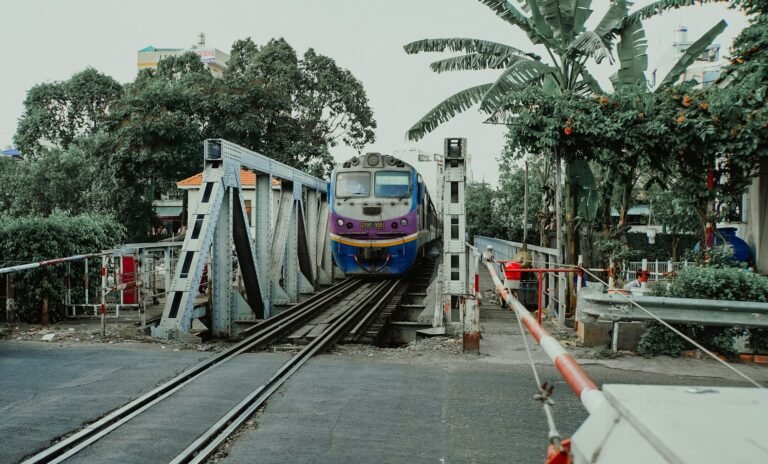Slow Paced Travel
Have you ever thought about experiencing Vietnam by train? It may not be the fastest way to travel, but it offers a window into local life and scenery that you won’t get from the air or highway. The country’s rail system is simple, and it all revolves around a single-track meter-gauge line that links Hanoi to Ho Chi Minh City. If you’re ready to discover more, read on.
Types of Trains
- Vietnam does not have high-speed services. All trains run on traditional single-track lines.
- The primary route stretches 1,726 km between Hanoi and Ho Chi Minh City. It can take over 30 hours, with average speeds around 50–60 km/h.
- Most trains are diesel-powered, offering soft sleepers (4-berth), hard sleepers (6-berth), and both soft and hard seats.
- The main line is often called the “Reunification Express,” but you’ll also find branch lines from Hanoi to Hai Phong (convenient for Ha Long Bay) and Hanoi to Lao Cai (gateway to Sapa).
- Services vary in speed and stops: basic TN trains stop everywhere, while SE “express” trains skip some stations.
Are you wondering who operates these trains and whether you’ll have multiple companies to choose from?
The answer is straightforward.
Railway Companies
- Vietnam Railways (VNR) is state-owned and runs passenger services nationwide.
- Different subsidiary companies exist under VNR, but they coordinate schedules and ticketing as a single system.
- Private or tourist charter companies attach their own sleeper cars to VNR trains on some routes, but you’ll still be under the main VNR timetable.
Maybe you’re planning your route and wondering where to get your tickets.
Is it best to buy them online or in person?
Where to Buy Tickets
- You can purchase them on the official VNR e-ticket site (dsvn.vn or vietnamrailway.vn). This site can be tricky for foreign cards, so many travelers prefer Baolau.com or 12Go Asia for convenience.
- At the station, look for the “Bán vé” (Tickets) counter. Larger stations usually have English-speaking staff.
- You must show your passport or ID when buying and again when boarding.
- It’s wise to book in advance, especially around holidays or for popular sleeper routes.
- Open-date tickets can sometimes be purchased through travel agencies if you plan to hop on and off the main line.
Do you like visual aids to plan your journey?
A railway map might be handy.
Railway Maps
- Vietnam’s network is straightforward. The north–south line is the backbone, with a few spur lines.
- Major stations often display a map, and you can also find one on the official VNR website.
- Future projects (standard-gauge high-speed lines) appear as dotted lines on some maps but are not yet operational.
How important is cleanliness to your journey?
Train conditions in Vietnam vary but are generally acceptable.
Cleanliness
- Carriages are cleaned before departure, and sleeper berths have linens (sheets, pillows, blankets) that are usually fresh.
- Wear and tear is common. Floors can get dusty on long trips, and toilets may lose some cleanliness after many hours.
- Hand sanitizer and your own toilet paper are good items to bring.
- Newer trains sometimes have modern restrooms and onboard Wi-Fi.
- Soft sleeper or tourist-focused coaches are typically cleaner and less crowded.
Do you prefer speed above everything else?
You’ll need to consider something other than rail if you’re in a hurry.
Speed
- Typical passenger trains average 50–60 km/h.
- The journey from Hanoi to Ho Chi Minh City takes 32–37 hours.
- Express trains (SE-series) reach about 70–90 km/h in some parts, but single-track infrastructure and curves slow them down.
- You might spot a “high-speed” diesel railcar on certain routes, yet track limitations keep speeds moderate.
- The benefit of this slower pace? You’ll get to enjoy views of rice fields, coastlines, and mountains.
Still have questions about planning?
Modern travel apps can smooth out the details.
Travel Apps & Websites
- Vietnam Railways’ website (dsvn.vn) and official app list timetables and sell e-tickets.
- Baolau.com and 12Go Asia offer instant booking and an easier interface, plus they show schedules in English.
- Google Maps integrates some train schedules, though fare and class details might be missing.
- VNR also has a Facebook page for updates and inquiries.
Traveling by train in Vietnam means embracing a slower rhythm. You’ll have plenty of time to watch the countryside roll by and meet local passengers. You might not arrive as quickly as you would by plane, but you’ll get a memorable taste of the country’s landscapes and daily life.
So, are you ready to pack your bag and board a sleeper car bound for Da Nang or Ho Chi Minh City? Enjoy the journey, take your time, and remember to bring some extra tissue. With the resources available and a bit of preparation, you’ll find that Vietnam’s railway network offers a fascinating travel experience that goes beyond simple transportation.





